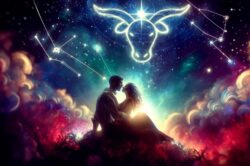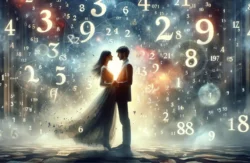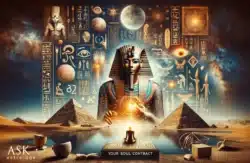Astrology provides a vast array of symbols that are used to interpret human existence. From the walls of ancient Egyptian temples to the delicately crafted pottery of Greece, from the alignments in Indian architecture to the intricate mosaics of Rome, astrology symbols have been artistically etched across time and cultures. This article embarks on a journey through history to explore how astrology symbols have manifested in ancient art.
Join me on this illuminating exploration of art and astrology, where the heavens meet the artistic side of the human hand.
Next after this publicity
Cave Paintings
The presence of astrology symbols in cave paintings has been a subject of intrigue and debate among art historians. While the evidence is not always straightforward some scholars have identified depictions of phenomena and astrological symbols in prehistoric cave art. Although these symbols may not align with the zodiac system they do indicate an early human fascination with the stars and the universe.
Let’s delve into a few examples:
Lascaux Caves (France)
The Lascaux Caves dating back approximately 17,000 years showcase paintings that some researchers believe might represent celestial objects and constellations. The section referred to as the “Hall of the Bulls” has been interpreted as a depiction of the Pleiades star cluster and the Taurus constellation.
Next after this publicity
Cueva de El Castillo (Spain)
El Castillo cave houses one of the known cave paintings featuring a series of dots and lines that could symbolize different phases of the moon. This suggests an early attempt by humans to track cycles and potentially indicates a rudimentary astrological or astronomical system.
Catalhoyuk (Turkey)
Within this settlement there are wall paintings portraying what appears to be a volcanic eruption alongside celestial objects. Some scholars have interpreted these depictions as attempts to represent events potentially signifying a connection between earthly happenings and cosmic order.
The Beginnings in Mesopotamia
The earliest structured zodiac system can be traced back to the Sumerians, who laid the foundational principles of astrology. Later, the Babylonians in Mesopotamia expanded and refined this astrological system.
These civilizations documented their observations on cuneiform tablets, noting the movements of celestial bodies, their positions at different times of the year, and their correlations with earthly events.
Next after this publicity
The influence of the Sumerian and Babylonian zodiac resonated across neighboring cultures. The Greeks, for instance, were significantly inspired by Babylonian astrological thought, adapting and transforming it into a system that would become synonymous with Western astrology.
Tropical vs Sidereal
There are two zodiac systems that have emerged over time. The first is the Tropical Zodiac, predominantly used in astrology, which is based on the Earth’s position in relation to the Sun and seasons. It begins with Aries at the equinox.
The second is the Sidereal Zodiac, which holds prominence in traditions like Vedic astrology and relies on the positions of constellations in the sky.
Egypt
Temple of Hathor
Located in Dendera, the Temple of Hathor is one of the best-preserved temple complexes in Egypt. It’s here that one of the most intricate and detailed star maps, known as the Dendera Zodiac, can be found.
The Dendera Zodiac showcases an array of mythological figures, constellations, and planets. Unlike the familiar twelve signs we know today, this zodiac combines traditional Egyptian symbols with some signs recognizable from later Greco-Roman zodiac systems.
The Dendera Zodiac was a means to represent the divine order and the cyclical nature of life. Researchers believe it might have also played a role in ritualistic ceremonies aimed at harnessing universal energies.
The Pharaoh’s
The pharaoh was not just a ruler but also a divine being, bridging the mortal realm with the heavens. Stars and constellations were seen as the dwelling places of deities and the souls of past pharaohs.
The constellation Orion, associated with Osiris (god of the afterlife, death, and rebirth), played a significant role in royal ideology. The three pyramids of Giza are believed to be aligned with the three stars in Orion’s belt, signifying the pharaoh’s association with the divine Osiris.
The star Sirius, the brightest star in the sky, was associated with the goddess Isis. It’s annual rising just before the Sun marked the onset of the Nile’s flooding.
Pyramid Texts
The Pyramid Texts, ancient religious texts carved on the walls of pyramids, often mention stars and constellations. These texts describe the pharaoh’s journey into the heavens, becoming one with the stars and securing eternal life.
Valley of the Kings
Several tombs in the Valley of the Kings have star maps painted on the ceiling, reflecting the night sky. These maps served as guides for the departed souls, aiding them in their journey through the afterlife and ensuring their rebirth among the stars.
For the ancient Egyptians, the stars weren’t just lights in the sky. They were guides, deities, and the eternal resting places of their divine rulers.
Mesopotamia
Cradle of Astrological Thought
Ancient Mesopotamia, one of the oldest civilizations in the world, made great progress in observing and recording cosmic movements. They used cuneiform, the form of writing to inscribe their observations on clay tablets.
The Sumerians initially followed a calendar that divided the sky into different sections or zones that the Moon would pass through. Over time these sections became associated with patterns of stars or constellations.
The early Enuma Anu Enlil tablets, dating back to around 1800 BCE, contain some mentions of signs and divination practices. Through these tablets, we can glimpse into attempts to predict events based on celestial observations.
Around 700 BCE, the Babylonians established a zodiac system that divided the sky into twelve signs. Each sign was represented by a symbol, many of which are still recognized in today’s zodiac.
Through their interactions with Babylonians, the Greeks became acquainted with these systems. During the expansion of the Roman Empire, they acquired a wealth of knowledge from the regions they conquered. They adapted the Babylonian Greek astrological system into their own, which eventually led to the familiar Latin names of zodiac signs we use today.
Greece
Adoption and Adaptation
The Greeks embraced the zodiac system from knowledge. They seamlessly integrated it into their own rich mythological traditions. As a result, the Greek Zodiac became a part of Hellenistic culture, resonating in aspects of daily life.
The period known as the Hellenistic era played a crucial role in the development of astrology. Scholars such as Claudius Ptolemy made contributions to texts like the “Tetrabiblos,” which served as a foundational work for Western astrology.
In mythology each of the twelve zodiac signs was associated with deities and myths. Similarly, the planets were named after gods to reflect their characteristics.
Influence of Mythology on Zodiac Interpretations
Aries, The Ram of the Golden Fleece
Aries symbolizes leadership and valor, drawing inspiration from the captivating tale of Jason and his quest for the Golden Fleece in mythology.
Taurus, Zeus, and Europa
Taurus represents fertility and strength inspired by the story of Zeus transforming into a bull to win over Europa’s heart.
Gemini and Pollux
Gemini embodies duality and communication, reflecting upon the bond between Castor and Pollux, the sons born to Spartan Queen Leda.
India
The Zodiac in Vedic Astrology
Vedic Astrology, also known as Jyotisha, has its origins in the traditions of India. It is a part of the Vedas, which are the oldest sacred texts in Indian philosophy.
Vedic astrology encompasses 27 Nakshatras, which represent portions of the sky that the Moon travels during its cycle. Each Nakshatra is associated with deities, symbols, and qualities.
Rasis refer to the twelve zodiac signs utilized in Vedic astrology like the twelve signs found in astrology. They serve as a backdrop for Nakshatras.
Vedic astrology incorporates concepts such as planetary positions (Grahas) to construct comprehensive birth charts. This system serves as a guide for spiritual growth and self-awareness.
Zodiac Symbols, in Ancient Temples and Sculptures
Numerous ancient Indian temples showcase carvings depicting zodiac symbols, Nakshatras, and planetary deities. Indian temples, such, as the Sun Temple in Konark and the Meenakshi Temple in Madurai, feature sculptures representing the Navagrahas and the nine astrological planets, including the Sun, Moon, and other planetary bodies.
Some temples, like the Brihadeshwara Temple, were designed with attention to universal alignments.
Another fascinating aspect is the use of Yantras, which are Diagrams employed in rituals that are often adorned with zodiac symbols.
China
The Lunar Zodiac and Its Twelve Animals
The Chinese zodiac, which consists of twelve animals representing a 12-year cycle has its roots in the Han Dynasty (206 BCE–220 CE). Unlike the zodiac that follows the Sun’s movements, the Chinese system is based on a calendar.
The Chinese zodiac includes twelve animals: Rat, Ox, Tiger, Rabbit, Dragon, Snake, Horse, Goat, Monkey, Rooster, Dog, and Pig. People born in a specific year embody the qualities of that animal.
Various myths explain the order of these animals in the zodiac. One such myth is about the Great Race organized by the Jade Emperor. Additionally, these animals are linked to Yin and Yang principles as other fundamental aspects of Chinese philosophy, like the Five Elements (Wood, Fire, Earth, Metal, Water).
Artistic Depictions: From Pottery to Palace Walls
Ancient pottery and porcelain have been adorned with zodiac symbols showcasing the significance and aesthetic admiration for the zodiac signs.
Zodiac motifs are often found in the Forbidden City and other imperial structures, highlighting the connection between authority and astrology.
Classical Chinese paintings often feature representations of the zodiac animals infused with meanings and artistic expressions.
Public spaces like parks and gardens showcase sculptures and artwork inspired by the zodiac animals.
Rome
The Integration and Spread of Zodiac Art
During ancient Roman times, mosaics gained popularity as an art form, especially in Rome, with zodiac patterns adorning floors, walls, and public buildings.
In numismatics, zodiac symbols and deities were utilized to symbolize authority, divine connections, and the empire. The use of coins featuring zodiac signs played a role in spreading imagery throughout society.
The design and layout of structures such as temples and bathhouses incorporated elements inspired by zodiac themes.
Roman sculptors frequently integrated zodiac signs into their works of art to establish a connection between achievements and divine wisdom. Remarkable relief works depicting cycles of the zodiac have been unearthed at sites showcasing the exceptional craftsmanship prevalent during that era.
Conclusion
Ancient societies saw the stars and planets to be of great importance, which is why they made great efforts to incorporate their symbolism into their art. By understanding how these civilizations connected with the cosmos, we can gain a deeper understanding of the true value and meaning of this ancient and valuable practice.
Side note: If you really want to take a deep dive into the history of zodiac art, consider checking out Tachen’s Library of Esoterica.





































